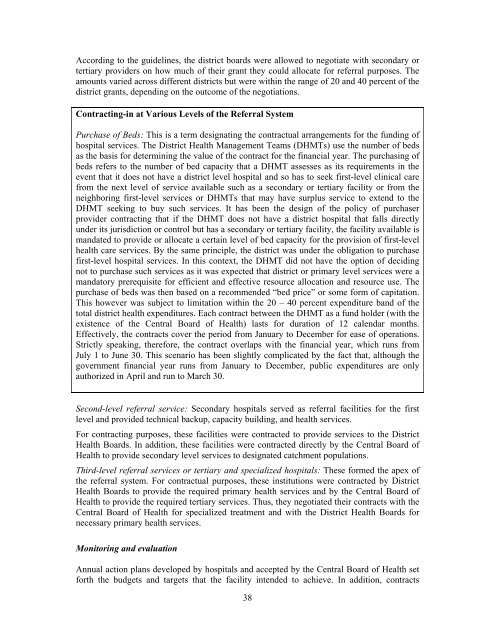Provider Purchasing and Contracting for Health Services_The Case
Provider Purchasing and Contracting for Health Services_The Case
Provider Purchasing and Contracting for Health Services_The Case
Create successful ePaper yourself
Turn your PDF publications into a flip-book with our unique Google optimized e-Paper software.
According to the guidelines, the district boards were allowed to negotiate with secondary or<br />
tertiary providers on how much of their grant they could allocate <strong>for</strong> referral purposes. <strong>The</strong><br />
amounts varied across different districts but were within the range of 20 <strong>and</strong> 40 percent of the<br />
district grants, depending on the outcome of the negotiations.<br />
<strong>Contracting</strong>-in at Various Levels of the Referral System<br />
Purchase of Beds: This is a term designating the contractual arrangements <strong>for</strong> the funding of<br />
hospital services. <strong>The</strong> District <strong>Health</strong> Management Teams (DHMTs) use the number of beds<br />
as the basis <strong>for</strong> determining the value of the contract <strong>for</strong> the financial year. <strong>The</strong> purchasing of<br />
beds refers to the number of bed capacity that a DHMT assesses as its requirements in the<br />
event that it does not have a district level hospital <strong>and</strong> so has to seek first-level clinical care<br />
from the next level of service available such as a secondary or tertiary facility or from the<br />
neighboring first-level services or DHMTs that may have surplus service to extend to the<br />
DHMT seeking to buy such services. It has been the design of the policy of purchaser<br />
provider contracting that if the DHMT does not have a district hospital that falls directly<br />
under its jurisdiction or control but has a secondary or tertiary facility, the facility available is<br />
m<strong>and</strong>ated to provide or allocate a certain level of bed capacity <strong>for</strong> the provision of first-level<br />
health care services. By the same principle, the district was under the obligation to purchase<br />
first-level hospital services. In this context, the DHMT did not have the option of deciding<br />
not to purchase such services as it was expected that district or primary level services were a<br />
m<strong>and</strong>atory prerequisite <strong>for</strong> efficient <strong>and</strong> effective resource allocation <strong>and</strong> resource use. <strong>The</strong><br />
purchase of beds was then based on a recommended “bed price” or some <strong>for</strong>m of capitation.<br />
This however was subject to limitation within the 20 – 40 percent expenditure b<strong>and</strong> of the<br />
total district health expenditures. Each contract between the DHMT as a fund holder (with the<br />
existence of the Central Board of <strong>Health</strong>) lasts <strong>for</strong> duration of 12 calendar months.<br />
Effectively, the contracts cover the period from January to December <strong>for</strong> ease of operations.<br />
Strictly speaking, there<strong>for</strong>e, the contract overlaps with the financial year, which runs from<br />
July 1 to June 30. This scenario has been slightly complicated by the fact that, although the<br />
government financial year runs from January to December, public expenditures are only<br />
authorized in April <strong>and</strong> run to March 30.<br />
Second-level referral service: Secondary hospitals served as referral facilities <strong>for</strong> the first<br />
level <strong>and</strong> provided technical backup, capacity building, <strong>and</strong> health services.<br />
For contracting purposes, these facilities were contracted to provide services to the District<br />
<strong>Health</strong> Boards. In addition, these facilities were contracted directly by the Central Board of<br />
<strong>Health</strong> to provide secondary level services to designated catchment populations.<br />
Third-level referral services or tertiary <strong>and</strong> specialized hospitals: <strong>The</strong>se <strong>for</strong>med the apex of<br />
the referral system. For contractual purposes, these institutions were contracted by District<br />
<strong>Health</strong> Boards to provide the required primary health services <strong>and</strong> by the Central Board of<br />
<strong>Health</strong> to provide the required tertiary services. Thus, they negotiated their contracts with the<br />
Central Board of <strong>Health</strong> <strong>for</strong> specialized treatment <strong>and</strong> with the District <strong>Health</strong> Boards <strong>for</strong><br />
necessary primary health services.<br />
Monitoring <strong>and</strong> evaluation<br />
Annual action plans developed by hospitals <strong>and</strong> accepted by the Central Board of <strong>Health</strong> set<br />
<strong>for</strong>th the budgets <strong>and</strong> targets that the facility intended to achieve. In addition, contracts<br />
38
















